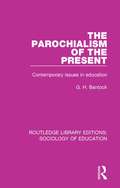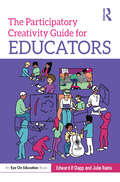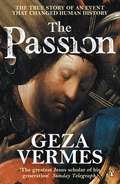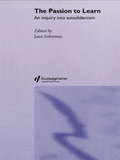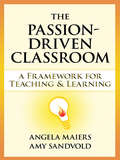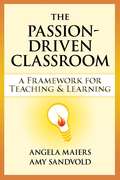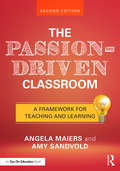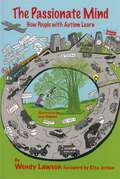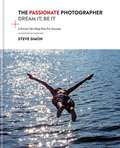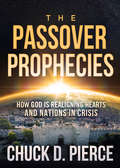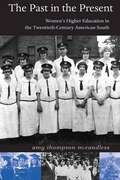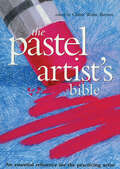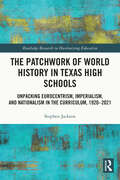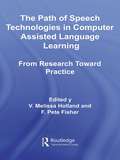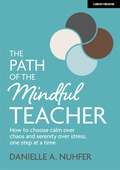- Table View
- List View
The Parochialism of the Present: Contemporary issues in education (Routledge Library Editions: Sociology of Education #3)
by G. H. BantockIn this controversial and challenging book, first published in 1981, the author calls for a restoration of the humanistic literary and historical balance in our educational thinking. He argues that the philosophy of education, seeking to emulate the precisions of science, concerns itself more with the analysis of words than with the real problems encountered in the educational world. Social science itself, he argues, would benefit by the promptings of literary insights. These essays constitute a systematic indictment of the narrowness of contemporary thinking about education, and will be of interest to students of education, philosophy and sociology.
The Participatory Creativity Guide for Educators
by Edward P. Clapp Julie RainsThe Participatory Creativity Guide for Educators debunks our outdated cultural understanding that some people are creative and others are not. Offering an embracing approach to creativity that encompasses invention and innovation, this practical guide reframes creativity as a mode of experience that all young people and adults have the opportunity to participate in.Bringing the principles of participatory creativity into the classroom, this book helps educators reframe invention and innovation, democratize the creative process, and leverage the knowledge, skills, background experiences, and cultural perspectives that students bring with them every day. Key concepts are illustrated through rich vignettes and pictures of practice as chapters walk you through the what, why, and how of incorporating participatory creativity into your teaching and learning environment.Designed for educators in a vast array of settings (including schools, community centers, museums, afterschool programs, and grandpa’s backyard workshop), this book is key reading for any educator looking to use creativity to strengthen and expand their teaching and learning.
The Particulars of Rapture: An Aesthetics of the Affects
by Charles AltieriThis brilliant, penetrating, and ambitious book by a well-known literary theorist studies the complex relationship between the emotions on the one side and literary works and paintings on the other. A central aim of Charles Altieri's is to rescue our understanding of the affects from philosophical theories that subordinate them to cognitive control and ethical judgment. Altieri concentrates on two fundamental aspects of aesthetic experience: the first describes how representative texts and paintings compose intricate affective states; the second engages how we might generalize from the values involved in the affects made articulate by works of art. He addresses a range of affective states, distinguishing carefully among sensations, feelings, moods, emotions, and passions. He shows how art solicits, organizes, and reflects upon affective energies and how many of the qualities of the affects developed within artworks simply disappear when observers are content with adjectival labels such as "sad," "angry," or "happy. " The Particulars of Rapture proposes treating affects in adverbial rather than in adjectival terms, emphasizing the way in which text and paintings shape distinct affective states. Such an emphasis places the manner in which artwork acts upon the emotions central to the quality of the resulting affect. And that emphasis in turn enables Altieri to show how a more general expressivist model for establishing and assessing values can compete with perspectives based on rationality.
The Particulars of Rapture: Reflections on Exodus
by Avivah Gottlieb ZornbergAvivah Zornberg grew up in a world of rabbinic tradition and scholarship and received a Ph. D. in English literature from Cambridge University. The Particulars of Rapture, the sequel to her award-winning study of the Book of Genesis, takes its title from a line by the American poet Wallace Stevens about the interdependence of opposite things, such as male and female, and conscious and unconscious. To her reading of the familiar story of the Israelites and their flight from slavery in Egypt, Avivah Zornberg has brought a vast range of classical Jewish interpretations and Midrashic sources, literary allusions, and ideas from philosophy and psychology. Her quest in this book, as she writes in the introduction, is "to find those who will hear with me a particular idiom of redemption," who will hear "within the particulars of rapture . . . what cannot be expressed. " Zornberg's previous book,The Beginning of Desire:Reflections on Genesis, won the National Jewish Book Award for nonfiction in 1995 and has become a classic among readers of all religions. The Particulars of Rapturewill enhance Zornberg's reputation as one of today's most original and compelling interpreters of the biblical and rabbinic traditions.
The Passion
by Dr Geza VermesIn his new book distinguished Jesus scholar Geza Vermes explains the true story behind The Passion of Christ and the recent, highly controversial, film. Vital reading for anyone wanting to know the truth behind the hyperbole Vermes's book is an intelligent and fascinating breakdown of the evidence of the Trial of Jesus and an authentic version of Stations of the Cross. A general introduction dealing with the Jewish court system, the Romen legal procedure and parallel court cases aims to provide a context to The Passion and a greater understanding of Biblical society. Written by the greatest Jesus scholar of his generation this will be required reading for anyone wanting to know the truth.
The Passion to Learn: An Inquiry into Autodidactism
by Joan SolomonThis is the first book to provide a detailed overview and analysis of autodidactism, or self-education. Autodidacts' strong preference for teaching themselves is likely to manifest itself, in childhood, as a pronounced resistance to formal schooling. However, in later life, an autodidact's passion for learning will emerge as they participate in open or distance learning or even take responsibility for devising, structuring and following their own programme of education.Beginning and ending with comprehensive and stimulating discussions of learning theories, The Passion to Learn includes fourteen case studies of autodidactism in informal learning situations, all written by authors with specialised knowledge. These wide-ranging case studies reflect the inherent diversity of autodidactism, yet four common themes emerge: emotional/cognitive balance; learning environment; life mission; and ownership of learning. The final chapter addresses the implications of autodidactism for educational theory, research, philosophy and psychology.This inquiry into autodidactism provides fresh insight into the motivation to learn. It shows how closely cognition, emotion and sensory perception act together in learning processes and draws upon memory studies, neurobiology, complexity theory and philosophy to illuminate the findings. At a time when such issues as participation in education, lifelong learning and alternative, non-formal modes of teaching and learning are in the forefront of international educational discourse, this fascinating, inspiring and timely book will be of great interest to anyone involved in the practice or policy of teaching and learning.
The Passion-Driven Classroom: A Framework for Teaching & Learning
by Angela Maiers Amy Sandvold<P>Discover ways to cultivate a thriving and passionate community of learners – in your classroom! In this book, educators and consultants Angela Maiers and Amy Sandvold show you how to spark and sustain your students’ energy, excitement, and love of learning. <P>This book presents ideas for planning and implementing a Clubhouse Classroom, where passion meets practice every day. In the Clubhouse Classroom, students learn new skills and explore their talents with the help of educators who are invigorated by the subjects they teach. <P>Contents include: <br>Achievement Gap or Passion Gap?, <br>A Passion-Driven Classroom: The Essentials, <br>Organizing the Clubhouse Classroom, <br>Managing the Clubhouse Classroom. <br>Learn how to move away from prescription-driven learning toward passion-driven learning, and begin to make a real difference in the lives of your students. <P>These strategies will help teachers in Grades K-12 put the "heart" back into teaching and learning – and make a lasting impact as educators!
The Passion-Driven Classroom: A Framework for Teaching and Learning
by Angela Maiers Amy SandvoldDiscover ways to cultivate a thriving and passionate community of learners in your classroom! In this book, educators and consultants Angela Maiers and Amy Sandvold show you how to spark and sustain your students energy, excitement, and love of learning. <p><p> This book presents ideas for planning and implementing a Clubhouse Classroom, where passion meets practice every day. In the Clubhouse Classroom, students learn new skills and explore their talents with the help of educators who are invigorated by the subjects they teach. <p> Learn how to move away from prescription-driven learning toward passion-driven learning, and begin to make a real difference in the lives of your students. These strategies will help teachers in Grades K-12 put the "heart" back into teaching and learning and make a lasting impact as educators!
The Passion-Driven Classroom: A Framework for Teaching and Learning
by Angela Maiers Amy SandvoldTurn your classroom into a thriving community of learners! In The Passion-Driven Classroom, bestselling authors Angela Maiers and Amy Sandvold show you how to spark and sustain your students’ energy, excitement, and love of learning. This updated edition offers a new framework for changing your mindset and implementing a passion-driven classroom, where passion meets practice every day as students learn new skills and explore their talents. You’ll come away with specific examples of how to set up your classroom, how to manage it, and how to assign passion projects where students take the lead. With this book, you’ll be able to move away from prescription-driven learning toward Passion-Driven Learning, so you can make a real difference in the lives of your students.
The Passionate Mind
by Wendy LawsonIn her new book, Wendy Lawson examines traditional theories about the autism spectrum (AS) and reveals their gaps and shortcomings. Showing that a completely different way of thinking about AS is needed, she sets forward the theory of Single Attention and Associated Cognition in Autism (SAACA), an approach that explains autism in terms of the unique learning style of AS individuals. The SAACA approach suggests that whereas neurotypical people can easily shift their attention from one task to another, those on the autism spectrum tend to use just one sense at a time, leading to a deep, intense attention. From the perspective of this new approach, Wendy describes practical outcomes for individuals, families, and places of education and employment, and shows that when the unique learning style of AS is understood, valued, and accommodated, AS individuals can be empowered to achieve their fullest potential. This is a fascinating read for anyone with a personal or professional interest in the autism spectrum, including clinical practitioners, educators, researchers, individuals on the spectrum and their families, teachers, occupational therapists, and other professionals.
The Passionate Mind of Maxine Greene: 'I am ... not yet'
by William F. PinarMaxine Greene is the most important philosopher of education in the United States today. The author of Teacher as Stranger (1973), Landscapes of Learning (1978), Dialectic of Freedom (1988), and Releasing the Imagination (1995), Greene has influenced tens of thousands of teachers in North America as well as her colleagues in philosophy of education, teacher education, and curriculum studies. While widely cited, Greene has not - until now - been the subject of sustained scholarly analysis and investigation. William F. Pinar has organized a systematic study of Greene's contribution from several points of view: studies of the four books; studies of the intellectual and aesthetic influences upon her theory; and her influence on the various specializations within the broad field of education: the teaching of English, arts education, philosophy of education, curriculum studies, religious education, cognitive theory, and theory of teaching. The book opens and concludes with Maxine Greene's own autobiographical statements.
The Passionate Photographer 2nd Ed: Ten Steps Towards Becoming Great: the Remastered Edition of the Bestselling Classic Work for All Photographers
by Steve SimonTake your passion for photography and close the gap between what you hope to achieve and what you do, following one of the world's most highly regarded photographers. This book will help you think about your photography and find a visual voice. It follows a clear structure which will make it useful for any reader, and is fully illustrated with Simon's own inspiring photography and some work from the historical greats. Simon's understanding of photography makes for a book filled with tips you can immediately fold into your own shooting, quickly establishing your own vision, learning what to concentrate on in a shot, and pushing you beyond your comfort zone. It also includes "lessons learned" from Steve's experience, so you can neatly side-step some problems even the pros have had to endure.
The Passionate Teacher
by Robert FriedAn inspiring handbook, enthusiastically embraced by teachers; with a new chapter Every teacher can be a passionate teacher-one who engages young people in the excitement of learning and ideas-if teaching is not undermined by the ways we "do business" in schools. The Passionate Teacher draws on voices, stories, and successes of teachers in urban, suburban, and rural classrooms to help you become, and remain, a passionate teacher despite the obstacles. This edition includes a new chapter for teachers beginning their careersFrom the Trade Paperback edition.
The Passover Prophecies: How God is Realigning Hearts and Nations in Crisis
by Dr. Chuck PierceGod is realigning hearts and nations in crisis. This book will allow you to hear what the Spirit is saying to the churches in this season of a modern-day Passover. A timely prophetic message on how to discern the times and know what to do as the body of Christ. As people and nations emerge in the aftermath of this pandemic, God will realign hearts and nations in preparation for an end-time harvest. BRIEF SUMMARY: One of America&’s most-respected prophetic voices brings a critical message to a nation—and world—at a crossroads. In September 2019, God revealed to Chuck Pierce that between February and April 2020, plague-like conditions would hit the earth. The Lord said, &“I will be waiting to see which nations &‘pass over.&’&” Just like the very first Passover, God is looking for a remnant that will hold strong and bring His love to a hurting planet. Pierce divides the rumors from the Word, and answers such questions as: Why would the current situation be happening around the time of Passover 2020?Is this a modern-day plague for a modern-day Passover?Are nations still trying to bring other nations under their control and economic rule?What is Israel&’s role in this critical time?How do we move forward today? In the midst of pandemic, God is also assuring His Church that after this period, for those who hold fast to Jesus, there will be a time of celebration. In The Passover Prophecies, Pierce delves into the ancient biblical signs that point toward a glorious future for the people of God. Move forward, feed your faith, and know that even in the midst of uncertainty, His kingdom shall overcome, and His will shall be done on Earth as it is in Heaven.
The Past in the Present: Women's Higher Education in the Twentieth-century American South
by Amy T. McCandlessThe history of higher education in the 20th-century South, like the history of the region, both mirrors and diverges from the national pattern. Not surprisingly the region’s demographic, economic, social, political, and cultural characteristics have accounted for many of the variations between the education of southern women and women in the rest of the nation.
The Past, Present, and Future of Higher Education in the Arabian Gulf Region: Critical Comparative Perspectives in a Neoliberal Era (Routledge Research in Higher Education)
by Awad Ibrahim Osman Z. BarnawiThis edited volume contributes a novel understanding of the past, present, and future of higher education across the six countries which make up the Gulf Cooperation Council (GCC). Against the backdrop of intense political, ideological, and epistemological disruptions across the Arabian Gulf Region over the last two decades, this volume adopts critical comparative perspectives in order to chart the history, present day, and future realities of higher education in Saudi Arabia, the United Arab Emirates, Oman, Qatar, Bahrain, and Kuwait. By focusing on dynamics relating to neoliberalism, and using the notions of ‘tensionality’ and ‘locality’ to situate topics such as curricula, policies, practices, the volume engages with current discourses, controversies, and themes such as the internationalization and marketization of high education in these countries. In doing so, the book offers a theoretical framework to enable greater understanding of the contemporary functioning of higher education in the Arabian Gulf Region. This text will benefit scholars, academics, and students in the fields of higher education and international and comparative education more broadly. Those involved with educational policy and politics, and Middle Eastern studies in general will also benefit from this volume.
The Past, Present, and Future of the Business School
by Edward W. MilesThis book examines the criticism that modern business schools face and how these obstacles have evolved throughout history. Through historical, resource, and professional school contexts, it sheds light on the operating environment of the business school and the challenges endemic to various university-based professional schools, exploring the likelihood that potential interventions will result in success or failure. Business schools are often accused of inhibiting the practice of business by producing research that is irrelevant and does not address real concerns facing managers. This book investigates these accusations by outlining the historical values on which academic institutions are based, the resources and funding available today, and comparisons to other professional schools which undergo a similar level of scrutiny. This extensive coverage will help academics, administrators, faculty, and policy makers with the tools to understand better the ill-will towards business schools in today's university structure, and ultimately to deliver on the benefits they provide to stakeholders.
The Pastel Artist's Bible: An Essential Reference for the Practicing Artist (Artist's Bibles Ser.)
by Claire Waite BrownA comprehensive guide to one of the most popular painting media—including materials, color, techniques, and subjects from still lifes to animals.Discover the unique joys of pastel painting with this easy-to-use guide to one of the most versatile and forgiving mediums. More than one hundred visual sequences reveal key techniques such as mixing, blending, scumbling, sgraffito, hatching and feathering. Includes tips on composing your painting, using color, adding highlights and shadows, and creating textured effects. Step-by-step demonstrations show how to approach a range of subjects from landscapes and flowers to portraits and still life. Over 65,000 copies sold worldwide.
The Pastor in Profile
by Adolph Bedsole Ralph G. TurnbullThis is a stimulating and provocative work. The writer has dipped his pen in an acid which smarts when applied, but its application is always in love and with goodwill. Abundant humor and laughter enable the reader to see himself in a mirror. The preacher under this treatment will benefit and be enriched morally and spiritually. Because the preacher is prone to tell others how to live, this book should bring a searchlight upon his own soul. Here is a plumbline of judgment and a method of self-scrutiny. The message is for the still hour and the chambers of imagery wherein the pastor dwells.The author’s style is lively and colorful. It moves swiftly and keeps one interested and intrigued. The stab and thrust of truth comes to the conscience. Occasionally there are lapses into slang, but possibly the author intends this in satirical vein? Throughout, the provocative element is well expressed, and in his own way he reveals much of what he has felt and experienced. In self reference he is free from egotism. This is good. No one will accuse him of being pharisaical or holier-than-thou.Periodically, ministers need to read a book of this kind “to see himself as others see him.” Let it be read then with open mind and obedient heart in the sight of the Lord!
The Pastoral Epistles: An Introduction and Commentary (Tyndale New Testament Commentaries #Volume 14)
by Osvaldo PadillaIn his New Testament letters to Timothy and Titus, the apostle Paul is concerned with church order, defending correct doctrine, and passing on the faith.In this introduction and commentary to both letters, Osvaldo Padilla sets them in their distinct context of Paul's later ministry and draws out their pastoral wisdom. With thoughtful exposition he shows how the lessons Paul imparts to Timothy and Titus are still relevant to us today and how we can learn from them in our own walk with Christ.The Pastoral EpistlesThe Tyndale New Testament Commentaries are ideal for students and teachers of theology and an excellent resource for preachers and individual Christians looking to broaden their knowledge and explore the riches of Scripture more deeply.
The Pastoral in Charles Griffes's Music: Aesthetic of Ambivalence
by Taylor A. GreerAt the turn of the century, visionary composer Charles Tomlinson Griffes synthesized highly diverse elements from other musical traditions into his distinct artistic voice. As American as he was far ranging in his interests, Griffes was an aesthetic polyglot, combining elements of literature, visual arts, global folk melodies, and contemporary European art music into a new musical language. The breadth of his sources of inspiration are breathtaking, including the sensual harmonies of fin-de-siècle French music, the British Aesthetic Movement, folk music drawn from the Middle East and Java, and a wide range of poets, including William Blake, Samuel Taylor Coleridge, and William Sharp. The Pastoral in Charles Griffes's Music explores both his music and the rich historical context from which it grew to enrich our understanding of the composer's artistic contribution and reveal new intersections and contradictions in European and American culture during the early twentieth century. Taylor A. Greer also critiques the philosophical foundation of topic theory and its relationship to the pastoral in Griffes's music to reflect on the end of the nineteenth century and clarify our understanding of his artistic influences. With Griffes's conception of the pastoral, he transformed the siciliana-based tradition he inherited from the eighteenth century into a new and vibrant genre that preserved the usual associations of simplicity and tranquility and introduced new elements of tension into the pastoral ideal, including global voices, paradox, and occasional conflict.
The Patchwork of World History in Texas High Schools: Unpacking Eurocentrism, Imperialism, and Nationalism in the Curriculum, 1920-2021 (Routledge Research in Decolonizing Education)
by Stephen JacksonThis book traces the historical development of the World History course as it has been taught in high school classrooms in Texas, a populous and nationally influential state, over the last hundred years. The author argues that the course has dynamically evolved to reflect a patchwork of competing visions that have intersected over the past century, with each new framework partially but never completely erasing or replacing those that came before. The first part of the book presents an overview of the World History course supported by a numerical analysis of textbook content and public documents, whilst the second focuses on the depiction of non-Western peoples, and persistent narratives of Eurocentrism, imperialism, and nationalism. It ultimately concludes that a more global, accurate, and balanced curriculum is possible, despite the tension between the ideas of professional world historians, who often de-center the nation-state in their quest for a truly global approach to the subject, and the historical core rationale of state-sponsored education in the United States: to produce loyal citizens. Offering a new, conceptual understanding of how colonial themes in world history curriculum have been dealt with in the past and are now engaged with in contemporary times, it provides essential context for scholars and educators with interests in the history of education, curriculum studies, and the teaching of World History in the United States.
The Path of Speech Technologies in Computer Assisted Language Learning: From Research Toward Practice (Routledge Studies in Computer Assisted Language Learning #Vol. 4)
by V. Melissa Holland F. Pete FisherThis collection examines the promise and limitations for computer-assisted language learning of emerging speech technologies: speech recognition, text-to-speech synthesis, and acoustic visualization. Using pioneering research from contributors based in the US and Europe, this volume illustrates the uses of each technology for learning languages, the problems entailed in their use, and the solutions evolving in both technology and instructional design. To illuminate where these technologies stand on the path from research toward practice, the book chapters are organized to reflect five stages in the maturation of learning technologies: basic research, analysis of learners’ needs, adaptation of technologies to meet needs, development of prototypes to incorporate adapted technologies, and evaluation of prototypes. The volume demonstrates the progress in employing each class of speech technology while pointing up the effort that remains for effective, reliable application to language learning.
The Path of The Mindful Teacher: How to choose calm over chaos and serenity over stress, one step at a time
by Danielle NuhferIn The Path of the Mindful Teacher, Danielle A. Nuhfer introduces educators to a process that will help them positively manage stress, find work-life balance, lessen symptoms of burnout, and increase classroom job satisfaction. Teachers walking this path will be able to determine their own needs and the needs of their students, so they can successfully and sustainably do one of the most important jobs in the world: teaching the future of our planet.Drawing on Danielle’s experience as a teacher, mindfulness practitioner, and teacher wellness coach, The Path of the Mindful Teacher will:• Explain the basics of mindfulness and how it can inform teaching practice.• Illustrate a simple step-by-step path that will help teachers choose calm over chaos and serenity over stress.• Provide ways to integrate mindfulness practice into the classroom and beyond.• Offer mindfulness activities that can be adapted to an individual teacher’s needs.• Present tools to balance the ever-changing landscape of teaching.
The Path of The Mindful Teacher: How to choose calm over chaos and serenity over stress, one step at a time
by Danielle NuhferIn The Path of the Mindful Teacher, Danielle A. Nuhfer introduces educators to a process that will help them positively manage stress, find work-life balance, lessen symptoms of burnout, and increase classroom job satisfaction. Teachers walking this path will be able to determine their own needs and the needs of their students, so they can successfully and sustainably do one of the most important jobs in the world: teaching the future of our planet.Drawing on Danielle’s experience as a teacher, mindfulness practitioner, and teacher wellness coach, The Path of the Mindful Teacher will:• Explain the basics of mindfulness and how it can inform teaching practice.• Illustrate a simple step-by-step path that will help teachers choose calm over chaos and serenity over stress.• Provide ways to integrate mindfulness practice into the classroom and beyond.• Offer mindfulness activities that can be adapted to an individual teacher’s needs.• Present tools to balance the ever-changing landscape of teaching.
